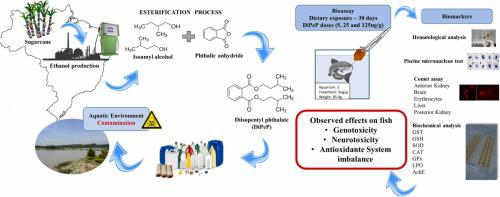Mutation Research/Genetic Toxicology and Environmental Mutagenesis ( IF 2.3 ) Pub Date : 2023-09-28 , DOI: 10.1016/j.mrgentox.2023.503702
Laís Fernanda Oya-Silva 1 , Izonete Cristina Guiloski 2 , Taynah Vicari 3 , Bruna Deda 1 , Fellip Rodrigues Marcondes 1 , Rafael Dias Simeoni 1 , Maiara Carolina Perussolo 4 , Anderson Joel Martino-Andrade 5 , Daniela Morais Leme 1 , Helena Cristina Silva de Assis 6 , Marta Margarete Cestari 1

|
Diisopentyl phthalate (DiPeP) is a plasticizer with significant offer and application in Brazilian industries. This is attributed to its origin, which is closely linked to the refining process of sugarcane for ethanol production in the country. In this work, we developed a model for trophic exposure to environmentally relevant doses (5, 25, and 125 ng/g of DiPeP) to identify possible target tissues and toxic effects promoted by subchronic exposure to DiPeP in a Neotropical catfish species (Rhamdia quelen). After thirty days of exposure, blood, liver, kidney, brain, and muscle were collected and studied regarding DNA damage in blood cells and biochemical analyses. The kidney was the most affected organ, as in the head kidney, genotoxicity was evidenced in all groups exposed to DiPeP. Besides, the caudal kidney showed a reduction in the superoxide dismutase and glutathione peroxidase activities as well as a reduced glutathione concentration. In the liver, exposure to 125 ng/g of DiPeP increased glutathione S-transferase activity and reduced glutathione levels. In muscle, acetylcholinesterase (AChE) was reduced. However, in the brain, an increase in AChE activity was observed after the exposure to lowest doses. In contrast, a significant reduction of brain AChE activity after exposure to the highest dose was detected. The pronounced genotoxicity observed in head kidney cells is of concern, as it may compromise different functions performed by this organ (e.g., hematopoiesis, immune and endocrine functions). In our study, DiPeP proved to be a compound of environmental concern since we have evidenced its nephrotoxic and neurotoxic potential even in low doses.
中文翻译:

亚慢性暴露于邻苯二甲酸二异戊酯后,银鲶鱼 Rhamdia quelen 的遗传毒性、神经毒性和抗氧化失衡的证据
邻苯二甲酸二异戊酯 (DiPeP) 是一种增塑剂,在巴西工业中具有重要的供应和应用。这归因于其起源,与该国用于生产乙醇的甘蔗精炼过程密切相关。在这项工作中,我们开发了一个营养暴露于环境相关剂量(5、25 和 125 ng/g DiPeP)的模型,以确定新热带鲶鱼物种 (Rhamdia quelen) 亚慢性暴露于 DiPeP 所促进的可能目标组织和毒性作用)。暴露三十天后,收集了血液、肝脏、肾脏、大脑和肌肉,并研究了血细胞中的 DNA 损伤和生化分析。肾脏是受影响最严重的器官,与头肾一样,所有暴露于 DiPeP 的组均显示出遗传毒性。此外,尾肾显示超氧化物歧化酶和谷胱甘肽过氧化物酶活性降低以及谷胱甘肽浓度降低。在肝脏中,暴露于 125 ng/g DiPeP 会增加谷胱甘肽 S-转移酶活性并降低谷胱甘肽水平。肌肉中的乙酰胆碱酯酶(AChE)减少。然而,在大脑中,在暴露于最低剂量后,观察到乙酰胆碱酯酶活性增加。相反,在暴露于最高剂量后,检测到大脑 AChE 活性显着降低。在头肾细胞中观察到的明显遗传毒性值得关注,因为它可能会损害该器官执行的不同功能(例如造血、免疫和内分泌功能)。在我们的研究中,DiPeP 被证明是一种引起环境问题的化合物,因为我们已经证明即使在低剂量下它也具有肾毒性和神经毒性潜力。

































 京公网安备 11010802027423号
京公网安备 11010802027423号